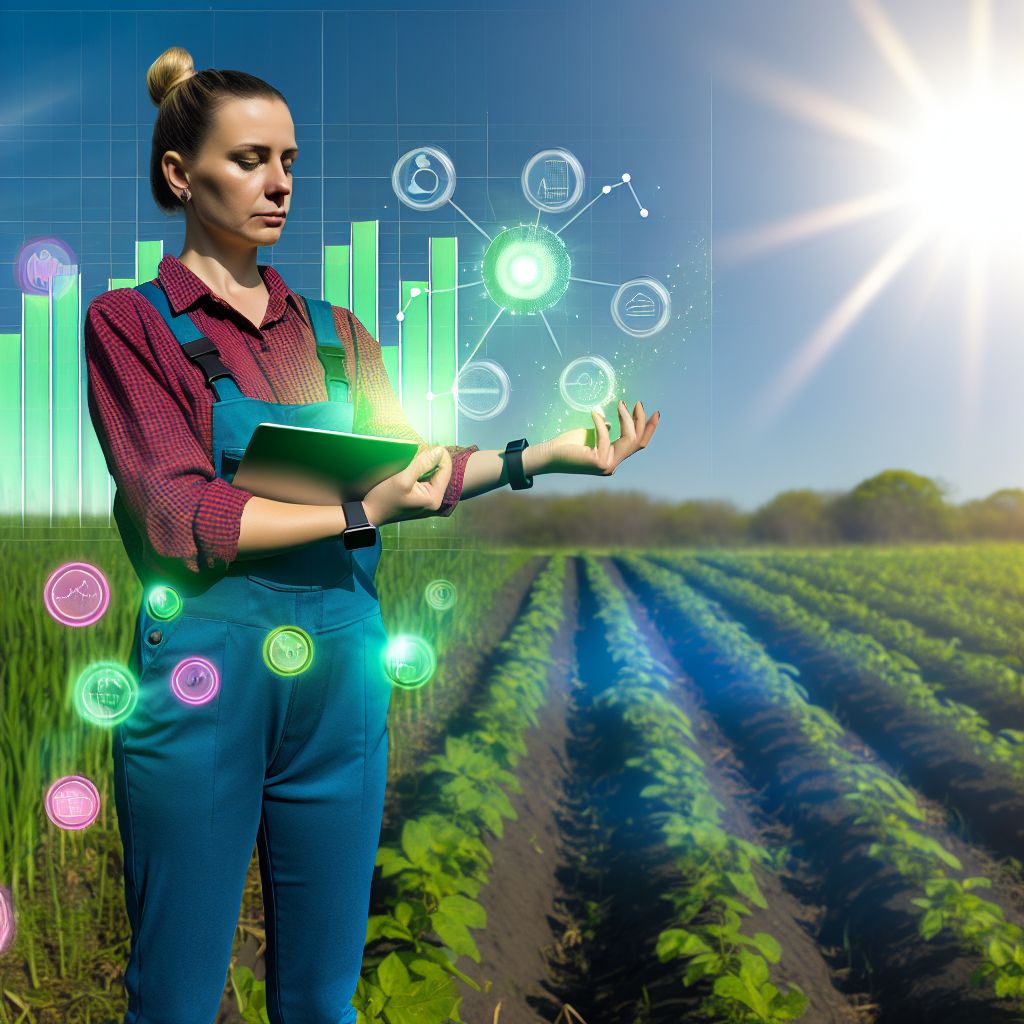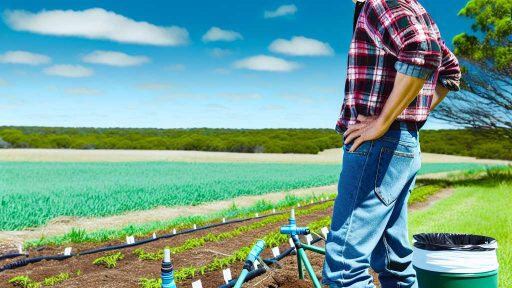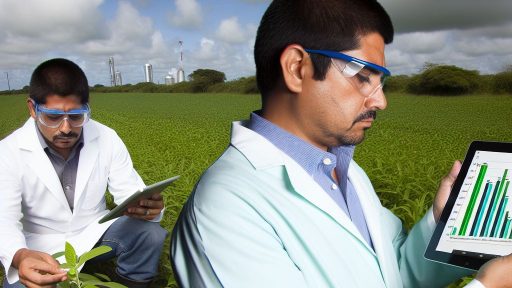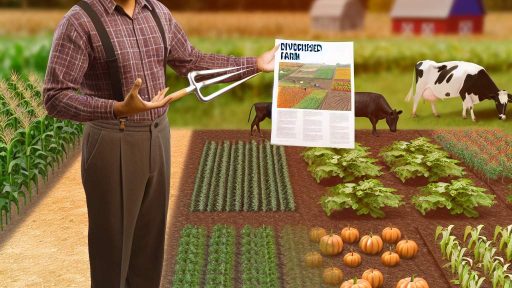Introduction to Data-Driven Decision Making in Agriculture
Data-driven decision making revolutionizes agriculture.
This approach empowers farmers to utilize factual insights.
Consequently, they can make better choices for their crops and livestock.
Advanced technology facilitates this shift towards data reliance.
Farmers now collect vast amounts of data from various sources.
The Importance of Data in Agriculture
Data enhances efficiency and productivity in farming.
It allows for precise resource allocation and management.
Farmers can track weather patterns and soil conditions effectively.
This information leads to informed decision-making and strategic planning.
Technologies Supporting Data Utilization
Several technologies drive data-driven agriculture.
Remote sensing technology gathers vital information from afar.
This tech aids in monitoring crop health and stress levels.
Additionally, IoT devices collect real-time data from the field.
Farm management software integrates various data sources seamlessly.
Challenges in Implementing Data-Driven Practices
Despite its advantages, challenges exist in data-driven farming.
Transform Your Agribusiness
Unlock your farm's potential with expert advice tailored to your needs. Get actionable steps that drive real results.
Get StartedData management can be complex and daunting for farmers.
Furthermore, ensuring data accuracy remains a critical concern.
Many farmers also face technology adoption barriers.
Training and education are essential for successful implementation.
Success Stories in the Industry
Many farms have successfully embraced data-driven decision making.
For example, GreenPastures Farm improved yield by 30%.
Through data analysis, they optimized irrigation and fertilization.
Similarly, Sunny Acres adopted precision agriculture techniques.
They used sensors and data analytics to enhance crop management.
The Importance of Data in Modern Farming Practices
Enhancing Decision-Making
Data-driven decisions greatly enhance modern farming practices.
Farmers rely on data to make informed choices about crop management.
For instance, data analysis helps in selecting the right seeds.
Consequently, this leads to improved yields and better quality produce.
Improving Resource Management
Data helps farmers optimize resource use.
Water management is more effective with data analytics.
Farmers can monitor moisture levels in real time.
This minimizes waste and ensures crops receive adequate hydration.
Predicting Market Trends
Data analytics allows farmers to predict market trends.
By analyzing market data, farmers can adjust production strategies.
This approach helps in meeting consumer demands effectively.
Moreover, it enhances profitability by targeting popular crops.
Enhancing Sustainability
Data also plays a crucial role in sustainable farming practices.
Farmers can track their environmental impact through data collection.
This insight guides them toward more eco-friendly farming methods.
Showcase Your Farming Business
Publish your professional farming services profile on our blog for a one-time fee of $200 and reach a dedicated audience of farmers and agribusiness owners.
Publish Your ProfileUltimately, the goal is to balance productivity with environmental care.
Facilitating Collaboration
Data fosters collaboration among farmers and agricultural professionals.
Shared data systems enable knowledge exchange and best practices.
Farmers can work together to solve common challenges.
This collaborative approach strengthens community resilience.
Types of Data Used in Agriculture
Satellite Imagery
Satellite imagery provides a vast array of information about agricultural land.
It offers real-time data for monitoring crop health and development.
This technology enables farmers to detect variations in crop growth.
Additionally, it aids in identifying areas that require more attention.
Farmers can utilize this data to optimize irrigation and fertilization strategies.
With satellite imagery, efficiency in resource use notably improves.
Soil Samples
Soil samples play a crucial role in data collection for agriculture.
These samples determine soil health and nutrient levels.
Farmers analyze soil composition to select appropriate crops.
Consequently, this data drives effective fertilization practices.
Soil testing also helps in optimizing water retention methods.
This approach ensures that crops receive maximum benefit from inputs.
Climate Data
Climate data significantly impacts agricultural decision-making.
Farmers rely on weather patterns to plan planting and harvesting schedules.
Understanding climate trends helps mitigate risks associated with adverse weather.
Furthermore, this data aids in determining suitable crop varieties for regions.
By analyzing past climate data, predictions for future seasons improve.
Ultimately, this information supports sustainable farming practices.
See Related Content: Precision Agriculture Tools Enhancing Farm Productivity
Tools and Technologies for Data Collection in the Agricultural Sector
Importance of Data Collection
Data collection plays a vital role in modern agriculture.
It helps farmers make informed decisions.
Accurate data enhances productivity and efficiency.
Moreover, it supports sustainable practices in farming.
Types of Data Collection Tools
Farmers can use various tools for data collection.
These tools can be software-based or hardware devices.
Mobile applications serve as an effective solution.
Moreover, IoT sensors provide real-time data.
GPS technology aids in crop mapping and tracking.
Software Solutions
Farm management software simplifies data handling.
These programs often include analytics tools.
Agricultural data management systems improve efficiency.
Furthermore, cloud-based solutions offer remote access.
Hardware Devices
Soil moisture sensors help monitor soil conditions.
Weather stations collect important meteorological data.
Drones provide aerial imaging for crop assessment.
Showcase Your Farming Business
Publish your professional farming services profile on our blog for a one-time fee of $200 and reach a dedicated audience of farmers and agribusiness owners.
Publish Your ProfileWireless sensor networks enable comprehensive data gathering.
Data Analysis Techniques
Once data is collected, proper analysis is crucial.
Machine learning algorithms process large data sets.
Data visualization tools enhance comprehension.
Statistical models support predictive analytics.
Challenges in Data Collection
Data privacy and security remain significant concerns.
Integration with existing systems can be complex.
Moreover, data accuracy and reliability are essential.
Farmers must be trained to effectively use technology.
See Related Content: Enhancing Visitor Experience With Unique Agritourism Activities
Case Studies: Successful Implementation of Data-Driven Strategies
Innovative Farming Solutions by GreenTech Agri
GreenTech Agri utilized data analytics to enhance crop yields.
They implemented precision farming techniques based on real-time data.
This included soil sensors and weather forecasts to optimize irrigation.
As a result, their crop production increased by 30% within a year.
Farmers reported reduced water usage and improved soil health.
Climate-Smart Agriculture at EcoHarvest Farms
EcoHarvest Farms focused on climate-smart agriculture practices.
They employed advanced analytics to assess climate risks.
This approach allowed them to select resilient crop varieties.
The data-driven decisions minimized losses caused by extreme weather.
Overall, EcoHarvest Farms enjoyed enhanced long-term sustainability.
Improving Supply Chains with AgriData Insights
AgriData partnered with local farmers to optimize supply chains.
They utilized data visualization tools to analyze market trends.
Farmers gained insights on demand fluctuations and pricing strategies.
This collaboration led to a reduction in post-harvest losses.
Consequently, farmers increased their overall profitability.
Maximizing Profits through Yield Monitoring at FarmTech Solutions
FarmTech Solutions introduced yield monitoring technology to farmers.
This technology uses drones and satellite imagery for analysis.
Farmers can now make informed decisions about planting and harvesting.
This data-driven approach resulted in maximizing crop outputs.
Farmers expressed satisfaction with the increased efficiency in their operations.
You Might Also Like: Effective Budgeting Strategies For Comprehensive Farm Financial Management

Challenges in Adopting Data-Driven Approaches in Farming
Technological Barriers
Many farmers struggle with outdated technology.
Limited access to high-speed internet hampers data utilization.
Moreover, the cost of advanced tools can be prohibitive.
These technological challenges create a steep learning curve.
Data Privacy Concerns
Farmers often worry about data security.
Sharing sensitive information can lead to misuse.
Additionally, many do not understand data ownership rights.
This lack of clarity discourages data collection and sharing.
Skills Gap
There is often a knowledge gap in data analytics.
Showcase Your Farming Business
Publish your professional farming services profile on our blog for a one-time fee of $200 and reach a dedicated audience of farmers and agribusiness owners.
Publish Your ProfileMany farmers lack training in data interpretation.
Consequently, they may misinterpret results.
Effective training programs are essential for bridging this gap.
Cultural Resistance
Some farmers resist changing traditional practices.
They may distrust new methods and technologies.
A strong belief in established routines is common.
Building trust in data-driven approaches is crucial.
Economic Factors
Data-driven farming initially requires significant investment.
Farmers face uncertainty about return on investment.
This ambiguity can deter financial commitment.
Farmers need support to make informed financial decisions.
Find Out More: Marketing Strategies For Successful Agritourism Businesses
Best Practices for Analyzing Agricultural Data to Enhance Productivity
Understanding Data Sources
Farmers collect data from various sources for analysis.
Weather patterns impact agricultural yields significantly.
Soil health data reveals crucial information about nutrient levels.
Crop yield history helps predict future performance.
Market trends provide insights into consumer preferences.
Utilizing Technology and Tools
Adopting precision agriculture technologies optimizes resource use.
Drones offer detailed aerial imagery for crop monitoring.
Farm management software streamlines data collection and analysis.
Data visualization tools aid in interpreting complex datasets.
IoT sensors provide real-time monitoring of environmental conditions.
Implementing Data Analysis Techniques
Statistical analysis reveals patterns and correlations in data.
Predictive analytics forecasts future trends and potential issues.
Machine learning algorithms refine decision-making processes.
Data mining uncovers hidden insights within vast datasets.
Benchmarking against industry standards identifies performance gaps.
Incorporating Feedback Mechanisms
Engaging with agronomists can enhance data interpretation.
Gathering feedback from farm workers improves operational efficiency.
Customer feedback helps tailor products to market demands.
Regular reviews of data analysis processes ensure continuous improvement.
Assessing the impact of implemented changes informs future decisions.
Making Informed Decisions
Data-driven decisions lead to improved crop management strategies.
Allocating resources effectively increases overall productivity.
Testing new methods based on data can yield better outcomes.
Investing in the right technology maximizes return on investment.
Collaboration with agricultural experts enhances knowledge and insights.
Future Trends in Data-Driven Agriculture
AI and Machine Learning Applications
The agricultural sector increasingly relies on AI and machine learning technologies.
These tools enhance productivity and streamline farming practices.
Farmers can analyze vast data sets to make informed decisions.
Showcase Your Farming Business
Publish your professional farming services profile on our blog for a one-time fee of $200 and reach a dedicated audience of farmers and agribusiness owners.
Publish Your ProfileFor instance, predictive analytics helps in forecasting weather conditions.
Another application involves optimizing planting schedules based on data.
Farm management software leverages AI to monitor crop health.
This technology aids in identifying pests and diseases early on.
Moreover, machine learning algorithms optimize irrigation systems.
They analyze soil moisture levels and weather patterns effectively.
Utilizing drone technology, farmers gather real-time data from fields.
Drones aid in assessing crop health and providing aerial imagery.
Furthermore, AI supports precision agriculture strategies.
This approach minimizes resource use while maximizing yields.
As a result, farmers can minimize their environmental impact.
Industry leaders, such as AgriTech Innovations, drive these developments.
They integrate advanced technologies into traditional farming practices.
Consequently, the future of agriculture appears brighter and more efficient.
Additional Resources
European Partnership “Agriculture of Data” Strategic Research and …
USDA Agri-Food Supply Chain Assessment: Program and Policy …




